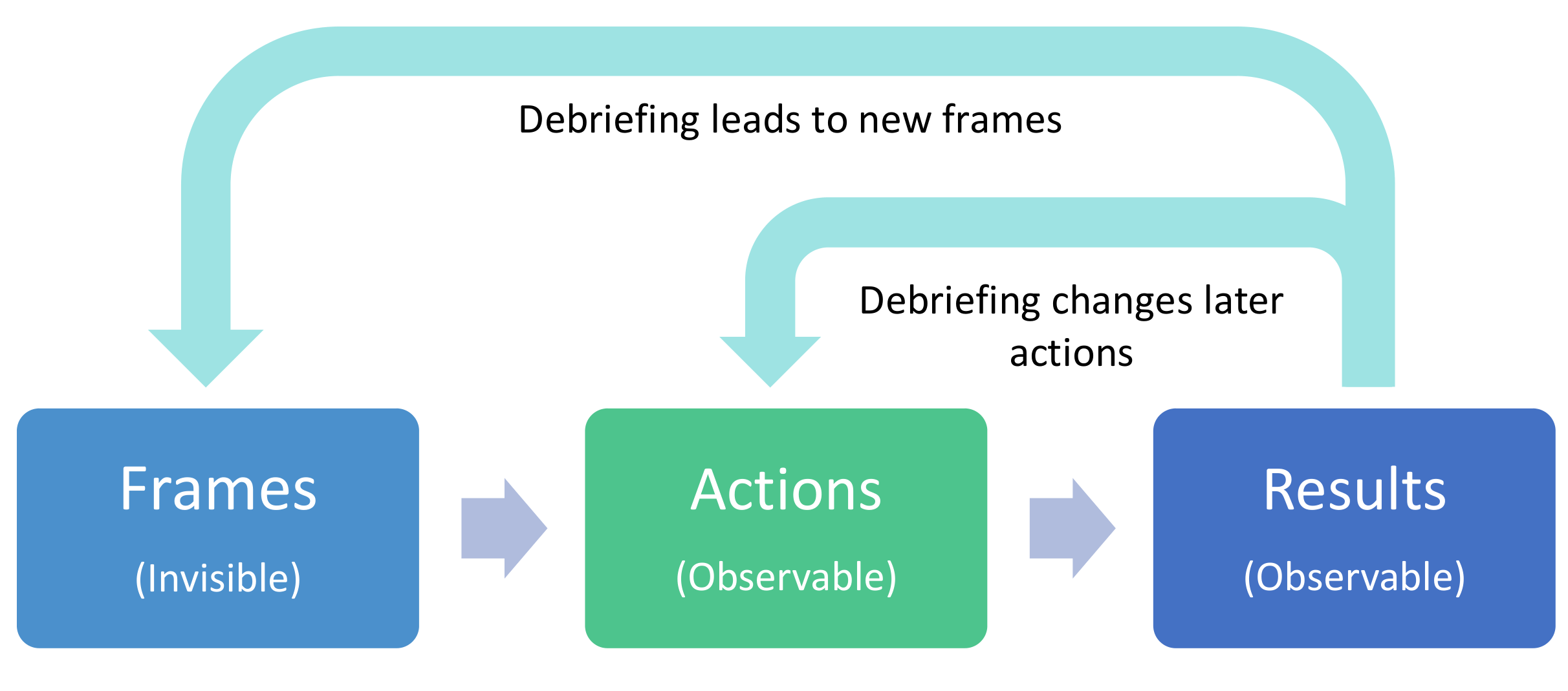Debriefing with Good Judgement
Sharing critical judgments is an essential part of learning in simulation and during any debrief. Teachers must deliver a critical message and share expertise while avoiding negative emotions, preserving social ‘face’ and maintaining their relationship with the trainee. However, this is often easier said than done. This article explores how debriefing with good judgement can help strike a suitable balance.
Actions in Context
Individuals apply meaning to their environment and make sense of external stimuli using internal cognitive frames. These frames shape the actions individuals take. Therefore, any mistakes may make perfect sense given how a person was framing the situation at that particular moment.
The aim during a debrief is to create an environment in which trainees feel both challenged and psychologically safe enough to engage in rigorous reflection. Reflective practice describes the discipline of examining ones' (taken for granted) values, assumptions, and knowledgebase that drives their actions. Those who successfully engage in reflection are able to self-correct and improve their skills.

The instructor should help the trainee bring these frames to the surface, analyse the impact they have on actions, and collaborate with the trainee in crafting new frames and actions for the future.
Poor Approaches to Debriefing
A Judgemental Approach
This places truth solely in the possession of the instructor and error in the hands of the trainee. It presumes there is an essential failure in the thinking or actions of the trainee. “Can anyone tell me what went wrong?”
This leads to humiliation, reduces motivation and creates reluctance to raise questions about later areas of confusion. It may even lead to the exit of talented trainees. Trainees are rarely left in doubt about what the instructor feels.
A Non-Judgemental Approach
This aims to deliver a critical message without negativity while maintaining trust. Strategies include sugar-coating errors, filtering out too-critical insights, the sandwich approach, avoiding a problem topic, or the use of Socratic leading questions.
Trainees may be confused about the nature of questioning or suspicious of the instructor’s unexplained motives. Hints of underlying motives may leak via the instructor's body language and conveys nonverbally that mistakes are not discussible or possibly shameful. The underlying assumption is the instructor is correct. Therefore, it is judgemental.
Practicing Debriefing with Good Judgement
This method focuses on creating a context for adult learners (including the instructor) to learn important lessons that will help them move toward key objectives. These objectives may be determined by the instructor or together with the trainees. The instructor initiates dialogue by explicitly sharing their view of the situation, whether they be critical or appreciative insights. The focus of the discussion then moves onto the trainee’s actions and their driving frames, knowledge and assumptions. This approach values both the expert opinion of instructor and the unique perspective of the trainees. The idea is to learn what frames drive the behaviours so that both failures and successes can be understood as an inevitable and logical solution to the problem as seen from the trainee's own individual frames. Instructors must be genuinely curious about the trainee’s frames and try to see mistakes as puzzles to solve. This can be achieved using a conversational technique known as advocacy and inquiry.
Advocacy with Inquiry
Advocacy with inquiry is a powerful action that makes frames visible. They are defined as:
Advocacy
An assertion, observation, or statement. It is the hypothesis.
Inquiry
A question which tests the hypothesis.
Together, this combination elicits the invisible frames that guide a trainee’s actions. Read more on advocacy with inquiry in our communication article. If instructors are truly curious in their inquiry, trainees will be able to learn from exploring their frames, while instructors can begin to see and understand the trainees’ thought processes. This provides a lever for deeper teaching and allows discussions to be directed toward learning objectives that are deeply meaningful to the trainee.
Learning can be improved by placing the instructors’ thoughts, judgments, and feelings front-and-centre. This makes the instructor vulnerable to the learning process and opens their views to challenge. The result is increased mutuality as it shows the instructor respects the trainee enough to value their perspective.
Take Home Messages
First: A trainee’s frame drives their actions. The instructor helps the learner by uncovering and reframing their internal assumptions to achieve better results.
Second: Instructors must be genuinely curious about the trainee’s frames and view mistakes as puzzles to solve.
Third: Advocacy inquiry is a technique that brings the instructor’s judgement and trainee’s frames to light.